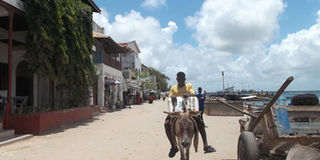Premium
Lamu: Small island that won’t let go its olden taste

Lamu town seafront . Photo/FILE
What you need to know:
- While new buildings are cropping up on the edges of the town, some narrow streets remain unchanged.
- Lamu is the smaller of the two most famous islands in the Lamu Archipelago, Lamu and Pate.
Lamu Old Town on Lamu Island is a UNESCO World Heritage Site.
The history of the town dates as far back as the 1300s, although one of the earliest records is of a Portuguese invasion in 1506 followed by the Omanis in 1800s.
While new buildings are cropping up on the edges of the town, some narrow streets remain unchanged.
Lamu was first established as a trading outpost. Its proximity to the deep waters, calm waters, and long accessible shoreline made it ideal as the hub of the East African stopover in the Northern sea trade route.
Lamu is the smaller of the two most famous islands in the Lamu Archipelago, Lamu and Pate.
The history of both islands dates back to the 7th Century, although only Lamu retains most of its relics.
It experienced several growth spurts during Oman and British occupation, and used the famous Shela battle to subjugate its neighboring islands and dominate the East African side of the Northern Sea.
MOST IMPORTANT SWAHILI SETTLEMENT
Today, Lamu remains the most important Swahili settlement on the Kenyan coast. Its main attractions are its Old Town, Lamu Fort, and the Swahili architecture in different parts of the island.
Lamu Fort, the main attraction in the town square, was built by the Sultan of Pate, Fumo Madi Abi Bakr.
He died long before the fort was completed in 1825 or 1826.
According the National Museum’s of Kenya website, the project was actually a diplomatic endeavour, where the Sultan of Oman, Seyyid Said, built the fort as part of his overtures on the island. Said’s Baluchi soldiers occupied the fort for a brief period before the arrival of the British.
Shela Beach, now a picturesque shoreline littered with villas and large luxurious houses, was once the site of a great battle between Lamu and her neighbours, Pate and Manda. The Shela Battle marked a focal point in Lamu’s history because it allowed it an opportunity to subjugate the larger and previously more powerful Pate.
But Pate faded because of other reasons. “Lamu’s advantage is not even its history but its conservation plan,” says Mohammed Ali Mwenje, a National Museums of Kenya Buildings Inspector in Lamu. “If Pate had a plan at the same scale as Lamu’s, it would have more to offer.”
As Pate slowly faded into oblivion, Lamu used its main attributes to become the most attractive and famous Swahili heritage site on the East African coastline, away from Zanzibar.
Lamu Old Town has maintained its authenticity. It has maintained its traditional style doors and buildings. Most of the Arabic and Indian doors are built of mangrove timber carved to provide stunning patterns. Its streets vary between the sections built during each occupation, with some Indian relics from a time when trade with India thrived on the Archipelago.
Centuries after the first Swahili ancestors settled on the island, Lamu maintains its history and heritage in the architecture and culture.
The original design of the town included very narrow streets that are still in place. Transport within the town is by donkeys. They number about 3000.




